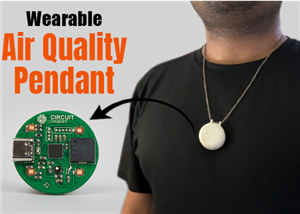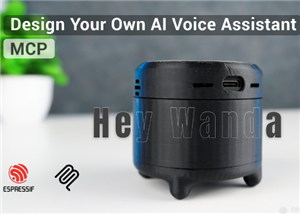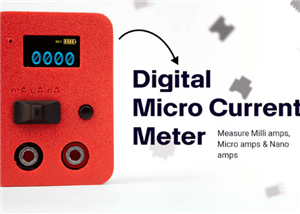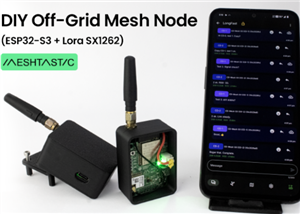|
|
ADUCM350BBCZAnalog Devices
|
x 1 | |
|
|
ESP32-WROOM-32UE-N4 |
x 1 |

|
KiCad 8.0KiCad
|
|
|
|
IAR Embedded Workbench for Arm |
Wireless Potentiostat for Electrochemical Analysis
This wireless potentiostat is based on the ADuCM355 SoC from Analog Devices, tailored for portable electrochemical sensing. This device, engineered on a custom PCB, brings laboratory-level electrochemical analysis to the field with a significantly reduced footprint and cost. The potentiostat integrates critical functions like potentiostat amplifiers, digital-to-analog converters (DACs), analog-to-digital converters (ADCs), and a microcontroller within the ADuCM355 IC. This highly integrated approach allows the design to minimize interconnects, which often lead to noise and signal loss in non-integrated systems. Using a four-layer PCB further optimizes performance, with dedicated power and ground planes in the middle layers for reduced noise propagation. The potentiostat also includes a USB-C connector for power and data transfer, enabling it to communicate seamlessly with computers or mobile devices through a USB-to-Serial interface chip.

While maintaining its compact size, the potentiostat's wireless functionality allows it to connect to mobile devices or computers for real-time data display and control. For this, we have utilised an ESP32 SoC as a wireless bridge, with the help of custom firmware. This feature is implemented via a graphical user interface (GUI) available on Android and Windows. The GUI allows users to set parameters for different electrochemical methods, including cyclic voltammetry (CV), square wave voltammetry (SWV), and electrochemical impedance spectroscopy (EIS). Results can be viewed immediately, saved, and exported in CSV format for detailed analysis.

Here are the PCB layers.




Schematic Diagram
Now let's look at the schematics for the wireless potentiostat.

Here we have used a USB type C port for charging the device, communication and firmware upgrade for the Wireless SoC. For charging the internal battery we have used the infamous TP4056 single-cell Li-ion battery charger chip since it is cheap and does the job well enough. For communication, I have opted for a CP2102N USB to UART controller chip from Silicon Labs because it performs well even with a higher baud rate and comes in a very compact package. And as for wireless communication, we are using an ESP32 SoC as a wireless UART bridge. I have also added precision to use a CH340K instead of CP2102 if needed. For powering the 3.3V logic we have used an ultra-low noise LDO, an ADM7154 from Analog Devices.
Apart from that the heart of the potentiostat is an ADuCM355 SoC from Analog Devices. The ADuCM355 Precision Analog Microcontroller offers an on-chip system that controls and measures electrochemical sensors and biosensors. This MCU comes with a chemical sensor interface and facilitates a mixed signal MCU which is based on Arm Cortex-M3 processor. The ADuCM355 Analog MCU is capable of current, voltage, and impedance measurements and features a 16-bit, 400kSPS ADC with ultralow leakage switch matrix and input MUX. This MCU operates at a 2.8V to 3.6V supply range and a -40°C to 85°C ambient temperature range. Typical applications include gas detection, food quality, blood glucose meters, and bioimpedance measurements.
The project is based on the Acestat project from ERDC. The new design included wireless functionality onboard battery charging and an optimised PCB layout for better results. Full details including hardware design files and firmware source code can be found on the Wireless potentiostat GitHub Repo.
Wireless Potentiostat for Electrochemical Analysis
*Due to unresolved design issues with this PCB, orders cannot be placed at this time. We appreciate your understanding.
- Comments(9)
- Likes(2)
-
 Engineer
Jul 21,2025
Engineer
Jul 21,2025
-
 Electronic Adam
Apr 13,2025
Electronic Adam
Apr 13,2025
- 0 USER VOTES
- YOUR VOTE 0.00 0.00
- 1
- 2
- 3
- 4
- 5
- 6
- 7
- 8
- 9
- 10
- 1
- 2
- 3
- 4
- 5
- 6
- 7
- 8
- 9
- 10
- 1
- 2
- 3
- 4
- 5
- 6
- 7
- 8
- 9
- 10
- 1
- 2
- 3
- 4
- 5
- 6
- 7
- 8
- 9
- 10
 More by Jobit Joseph
More by Jobit Joseph
-
 How to build a Wearable Air Quality Monitor Pendant using STM32 & SGP40 Sensor
This DIY Wearable Air Quality Monitor Pendant is a compact, battery-powered device designed to conti...
How to build a Wearable Air Quality Monitor Pendant using STM32 & SGP40 Sensor
This DIY Wearable Air Quality Monitor Pendant is a compact, battery-powered device designed to conti...
-
 Smart Digital Ludo Game Board with Multicolour PCB
Ludo, a beloved childhood game, holds a special place in our hearts with its simple and engaging gam...
Smart Digital Ludo Game Board with Multicolour PCB
Ludo, a beloved childhood game, holds a special place in our hearts with its simple and engaging gam...
-
 Electronic Dice with BLE Connectivity
Many of us fondly remember the joy of playing board games like Snakes and Ladders or Ludo during our...
Electronic Dice with BLE Connectivity
Many of us fondly remember the joy of playing board games like Snakes and Ladders or Ludo during our...
-
 3D printed Enclosure Backplate for Riden RD60xx power supplies
3D printed Enclosure for Riden RD60xx power supplies such as RD6006, RD6012, RD6018, RD6024 and RD60...
3D printed Enclosure Backplate for Riden RD60xx power supplies
3D printed Enclosure for Riden RD60xx power supplies such as RD6006, RD6012, RD6018, RD6024 and RD60...
-
 3D printed Enclosure for Riden RD60xx power supplies
3D printed Enclosure for Riden RD60xx power supplies such as RD6006, RD6012, RD6018, RD6024 and RD60...
3D printed Enclosure for Riden RD60xx power supplies
3D printed Enclosure for Riden RD60xx power supplies such as RD6006, RD6012, RD6018, RD6024 and RD60...
-
 Suzuki Ignis Universal Armrest No Screw Adapter
I own a 2024 Suzuki Ignis. When I searched for an armrest for my car I couldn't find any domesticall...
Suzuki Ignis Universal Armrest No Screw Adapter
I own a 2024 Suzuki Ignis. When I searched for an armrest for my car I couldn't find any domesticall...
-
 Wireless Potentiostat for Electrochemical Analysis
This wireless potentiostat is based on the ADuCM355 SoC from Analog Devices, tailored for portable e...
Wireless Potentiostat for Electrochemical Analysis
This wireless potentiostat is based on the ADuCM355 SoC from Analog Devices, tailored for portable e...
-
 160 Channel Configurable DAC Controller
The DAC controller board features 160 individually controllable 16-bit DAC output. It can output vol...
160 Channel Configurable DAC Controller
The DAC controller board features 160 individually controllable 16-bit DAC output. It can output vol...
-
 Build Your Own ESP32 AI Voice Assistant with MCP Integration
Project OverviewThe ESP32 AI Voice Assistant with MCP Integration is an advanced voice-controlled sm...
Build Your Own ESP32 AI Voice Assistant with MCP Integration
Project OverviewThe ESP32 AI Voice Assistant with MCP Integration is an advanced voice-controlled sm...
-
 Build Your Own Precision Digital Micro-Current Meter with STM32
In many electronic projects — especially those involving battery-powered devices or low-power sensor...
Build Your Own Precision Digital Micro-Current Meter with STM32
In many electronic projects — especially those involving battery-powered devices or low-power sensor...
-
 DIY Meshtastic Using ESP32 : Build Your Own Private Off-Grid Network
Project OverviewThis project delivers a complete, custom-designed PCB solution for building Meshtast...
DIY Meshtastic Using ESP32 : Build Your Own Private Off-Grid Network
Project OverviewThis project delivers a complete, custom-designed PCB solution for building Meshtast...
-
 Second PCB for ESP32 Smart Watch
This project contains two PCBs, this is the Second PCB,and there is a Main PCB, please click https:/...
Second PCB for ESP32 Smart Watch
This project contains two PCBs, this is the Second PCB,and there is a Main PCB, please click https:/...
-
 1S battery Charger with Battery level indicator and power path
1S Battery Charger with Battery level indicator and 5V out and standby mode.
1S battery Charger with Battery level indicator and power path
1S Battery Charger with Battery level indicator and 5V out and standby mode.
-
 Smart Universal Remote with Learning Function and Google Assistant Support
In our day-to-day life, we use various gadgets such as televisions, set-top boxes, air conditioners,...
Smart Universal Remote with Learning Function and Google Assistant Support
In our day-to-day life, we use various gadgets such as televisions, set-top boxes, air conditioners,...
-
 High-Resolution POV Display using ESP32
In this guide, we'll learn how to create a cool POV display using an ESP32 module. It's all about us...
High-Resolution POV Display using ESP32
In this guide, we'll learn how to create a cool POV display using an ESP32 module. It's all about us...
-
 Low Cost Drone using ESP32
Drones have rapidly evolved from niche hobbies to versatile tools with a wide range of applications,...
Low Cost Drone using ESP32
Drones have rapidly evolved from niche hobbies to versatile tools with a wide range of applications,...
-
 DIY Thermal Camera
Ditch X-ray vision, thermal cameras are the real industrial superheroes! They don't just see light, ...
DIY Thermal Camera
Ditch X-ray vision, thermal cameras are the real industrial superheroes! They don't just see light, ...
-
 ESP32 Smart Watch
This project contains two PCBs, this is the Main PCB, and there is a Second PCB, please click https:...
ESP32 Smart Watch
This project contains two PCBs, this is the Main PCB, and there is a Second PCB, please click https:...
-
-
mammoth-3D SLM Voron Toolhead – Manual Drill & Tap Edition
211 0 0 -
-
AEL-2011 Power Supply Module
735 0 2 -
AEL-2011 50W Power Amplifier
608 0 2 -
-
-
Custom Mechanical Keyboard
813 0 0 -
Tester for Touch Screen Digitizer without using microcontroller
440 2 2 -
Audio reactive glow LED wristband/bracelet with NFC / RFID-Tags
392 0 1 -
-














































